2019 FORD POLICE INTERCEPTOR light
[x] Cancel search: lightPage 5 of 370

Lighting
General Information
......................................61
Lighting Control ..............................................
61
Autolamps .......................................................
62
Instrument Lighting Dimmer ....................
63
Headlamp Exit Delay ...................................
63
Daytime Running Lamps ...........................
64
Direction Indicators ......................................
64
Interior Lamps ................................................
64
Windows and Mirrors
Power Windows ............................................
66
Exterior Mirrors ...............................................
67
Interior Mirror ..................................................
68
Sun Visors ........................................................
69
Instrument Cluster
Gauges ..............................................................
70
Warning Lamps and Indicators .................
71
Audible Warnings and Indicators .............
73
Information Displays
General Information .....................................
74
Information Messages .................................
77
Climate Control
Manual Climate Control .............................
83
Hints on Controlling the Interior Climate ........................................................................\
..
84
Heated Rear Window ..................................
85
Heated Exterior Mirrors ...............................
85
Cabin Air Filter ................................................
85
Seats
Sitting in the Correct Position ..................
86
Head Restraints .............................................
86
Manual Seats .................................................
88
Power Seats ....................................................
89Auxiliary Power Points
Auxiliary Power Points
................................
90
Storage Compartments
Center Console ...............................................
91
Overhead Console .........................................
91
Starting and Stopping the Engine
General Information .....................................
92
Ignition Switch ................................................
92
Starting a Gasoline Engine ........................
93
Engine Block Heater ....................................
94
Police Engine Idle Feature .........................
95
Fuel and Refueling
Safety Precautions .......................................
97
Fuel Quality - E85 .........................................
97
Fuel Quality - Gasoline ...............................
99
Fuel Filler Funnel Location ........................
99
Running Out of Fuel .....................................
99
Refueling ..........................................................
101
Fuel Consumption ......................................
104
Engine Emission Control
Emission Law ................................................
106
Catalytic Converter .....................................
107
Transmission
Automatic Transmission ...........................
110
All-Wheel Drive
Using All-Wheel Drive .................................
113
Brakes
General Information ...................................
120
Hints on Driving With Anti-Lock Brakes ........................................................................\
..
121
Parking Brake ..................................................
121
2
Police Interceptor (CPH) Police, Canada/United States of America, enUSA, Edition date: 201806, First-Printing Table of Contents
Page 11 of 370

Brake system
Cabin air filter
Check fuel cap
Child safety door lock or unlock
Child seat lower anchor
Child seat tether anchor
Cruise control
Do not open when hot
Engine air filter
Engine coolant
Engine coolant temperature
Engine oil
Explosive gas
Fan warning
Fasten seatbelt Flammable
Front airbag
Front fog lamps
Fuel pump reset
Fuse compartment
Hazard flashers
Heated rear window
Windshield defrosting system
Interior luggage compartment
release
Jack
Keep out of reach of children
Lighting control
Low tire pressure warning
Maintain correct fluid level
Note operating instructions
8
Police Interceptor (CPH) Police, Canada/United States of America, enUSA, Edition date: 201806, First-Printing IntroductionE270480 E71340 E71880 E231160 E67017 E161353
Page 15 of 370
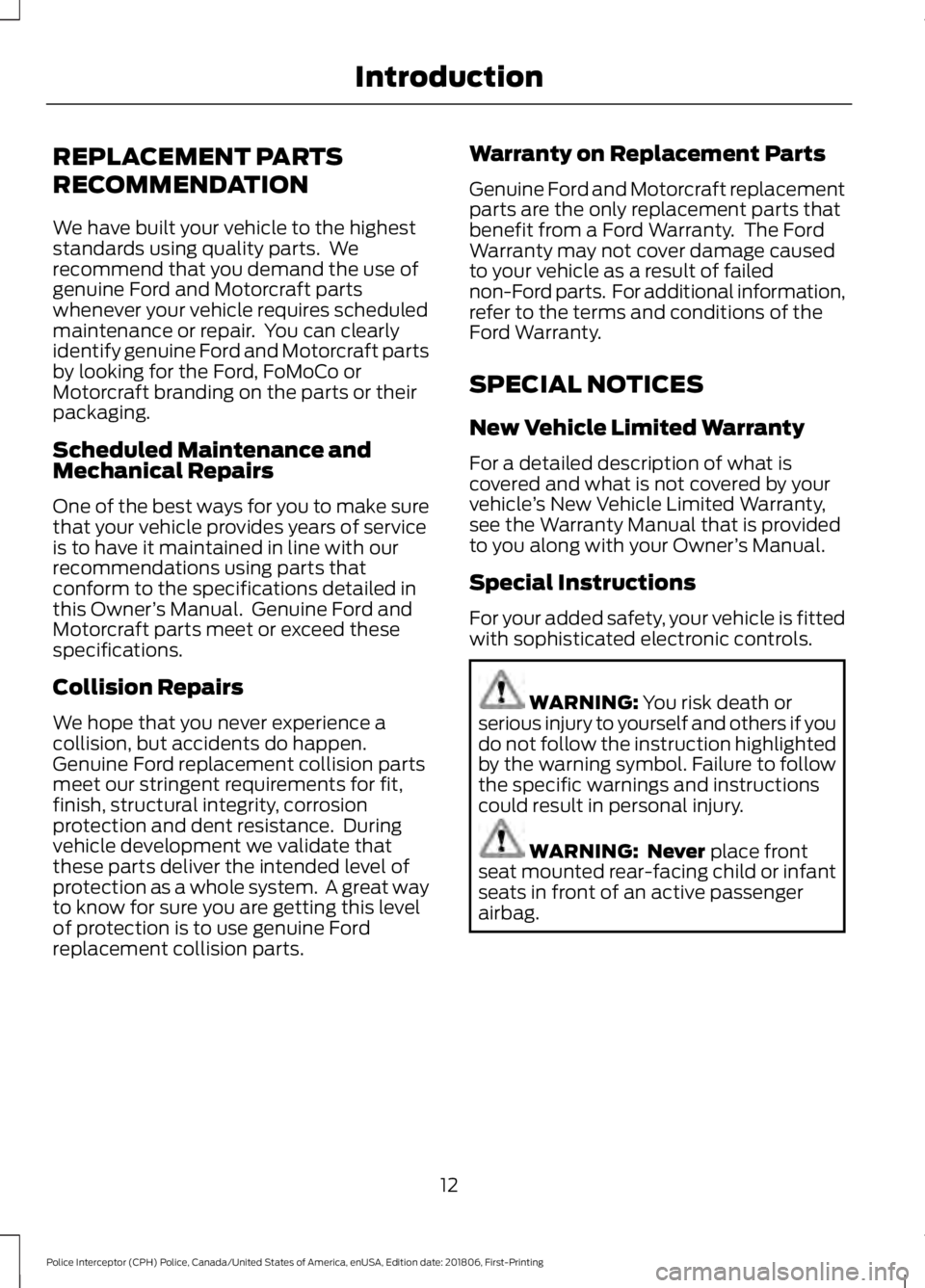
REPLACEMENT PARTS
RECOMMENDATION
We have built your vehicle to the highest
standards using quality parts. We
recommend that you demand the use of
genuine Ford and Motorcraft parts
whenever your vehicle requires scheduled
maintenance or repair. You can clearly
identify genuine Ford and Motorcraft parts
by looking for the Ford, FoMoCo or
Motorcraft branding on the parts or their
packaging.
Scheduled Maintenance and
Mechanical Repairs
One of the best ways for you to make sure
that your vehicle provides years of service
is to have it maintained in line with our
recommendations using parts that
conform to the specifications detailed in
this Owner
’s Manual. Genuine Ford and
Motorcraft parts meet or exceed these
specifications.
Collision Repairs
We hope that you never experience a
collision, but accidents do happen.
Genuine Ford replacement collision parts
meet our stringent requirements for fit,
finish, structural integrity, corrosion
protection and dent resistance. During
vehicle development we validate that
these parts deliver the intended level of
protection as a whole system. A great way
to know for sure you are getting this level
of protection is to use genuine Ford
replacement collision parts. Warranty on Replacement Parts
Genuine Ford and Motorcraft replacement
parts are the only replacement parts that
benefit from a Ford Warranty. The Ford
Warranty may not cover damage caused
to your vehicle as a result of failed
non-Ford parts. For additional information,
refer to the terms and conditions of the
Ford Warranty.
SPECIAL NOTICES
New Vehicle Limited Warranty
For a detailed description of what is
covered and what is not covered by your
vehicle
’s New Vehicle Limited Warranty,
see the Warranty Manual that is provided
to you along with your Owner ’s Manual.
Special Instructions
For your added safety, your vehicle is fitted
with sophisticated electronic controls. WARNING: You risk death or
serious injury to yourself and others if you
do not follow the instruction highlighted
by the warning symbol. Failure to follow
the specific warnings and instructions
could result in personal injury. WARNING: Never
place front
seat mounted rear-facing child or infant
seats in front of an active passenger
airbag.
12
Police Interceptor (CPH) Police, Canada/United States of America, enUSA, Edition date: 201806, First-Printing Introduction
Page 19 of 370

INSTRUMENT PANEL OVERVIEW
Air vent.
A
Wiper lever. See Windshield
Wipers (page 60).
B
Direction indicators.
See
Direction Indicators (page 64).
C
Information display control. See
Information Display Control
(page
58).
D
Instrument cluster.
See
Instrument Cluster (page 70).
E
Information display control. See
Information Display Control
(page
58).
F
Audio system. See
Audio
System (page 249).
G Hazard flasher switch.
See
Hazard Flashers (page 153).
H
Information and entertainment
display.
I
Passenger airbag indicator light.
See
Front Passenger Sensing
System (page 40).
J
Luggage compartment switch.
See
Locking and Unlocking
(page 53).
K
Climate controls. See
Climate
Control (page 83).
L
Ignition switch.
See Ignition
Switch (page 92).
M
Audio control.
See Audio
Control (page 57).
N
Horn.
O
16
Police Interceptor (CPH) Police, Canada/United States of America, enUSA, Edition date: 201806, First-Printing At a GlanceE277401
Page 20 of 370
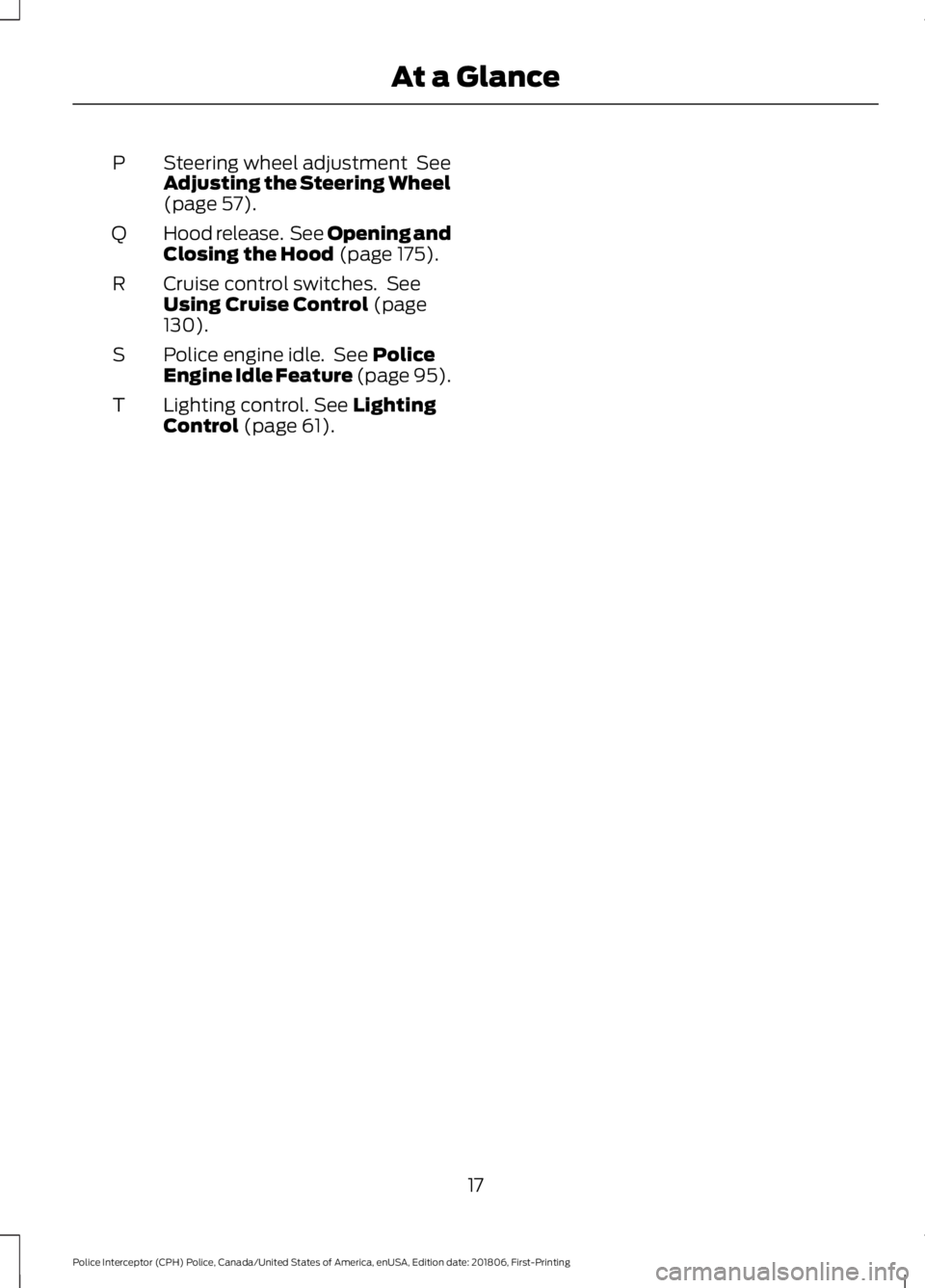
Steering wheel adjustment See
Adjusting the Steering Wheel
(page 57).
P
Hood release. See Opening and
Closing the Hood
(page 175).
Q
Cruise control switches. See
Using Cruise Control
(page
130).
R
Police engine idle. See
Police
Engine Idle Feature (page 95).
S
Lighting control.
See Lighting
Control (page 61).
T
17
Police Interceptor (CPH) Police, Canada/United States of America, enUSA, Edition date: 201806, First-Printing At a Glance
Page 25 of 370
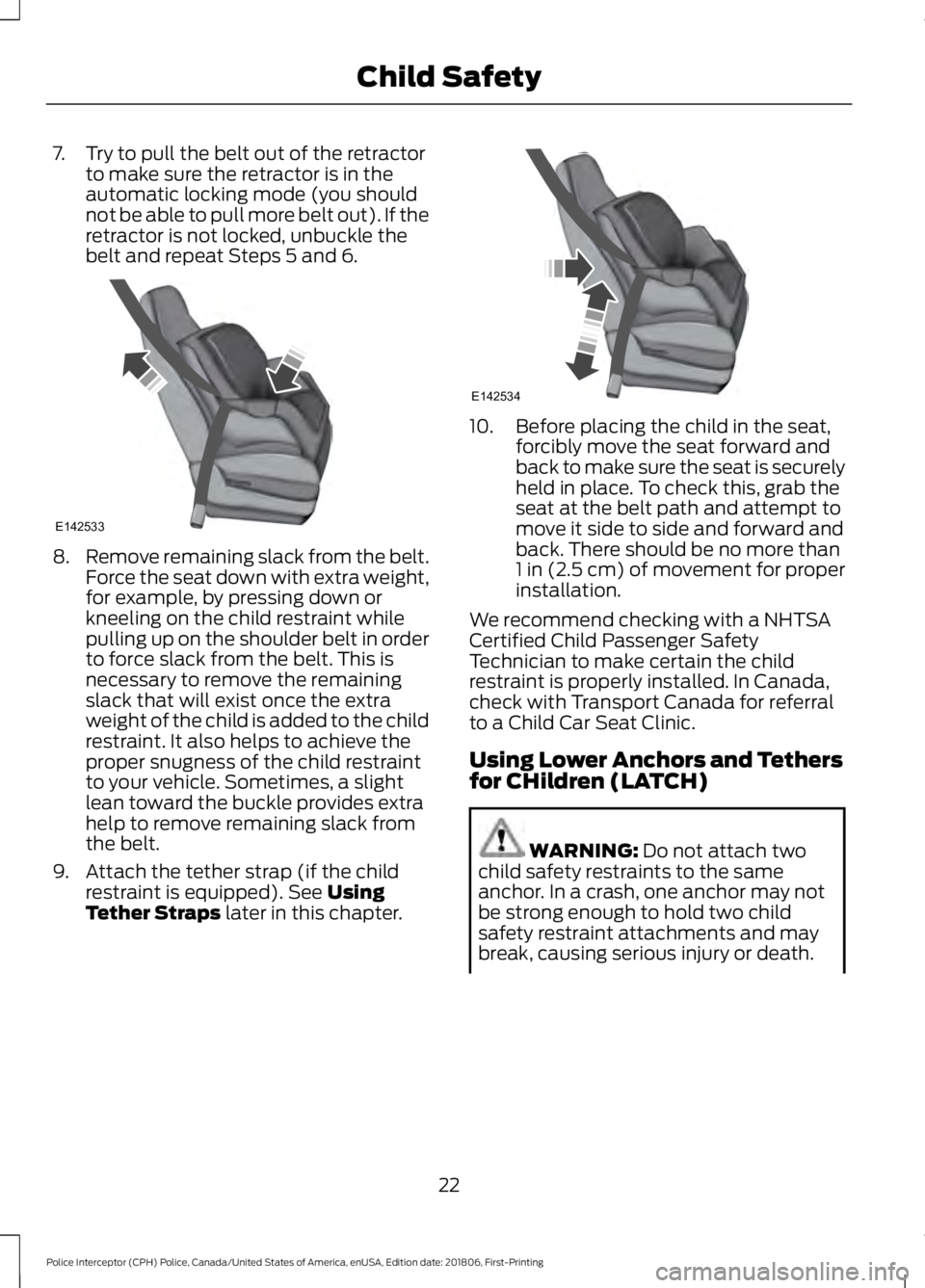
7. Try to pull the belt out of the retractor
to make sure the retractor is in the
automatic locking mode (you should
not be able to pull more belt out). If the
retractor is not locked, unbuckle the
belt and repeat Steps 5 and 6. 8.
Remove remaining slack from the belt.
Force the seat down with extra weight,
for example, by pressing down or
kneeling on the child restraint while
pulling up on the shoulder belt in order
to force slack from the belt. This is
necessary to remove the remaining
slack that will exist once the extra
weight of the child is added to the child
restraint. It also helps to achieve the
proper snugness of the child restraint
to your vehicle. Sometimes, a slight
lean toward the buckle provides extra
help to remove remaining slack from
the belt.
9. Attach the tether strap (if the child restraint is equipped). See Using
Tether Straps later in this chapter. 10. Before placing the child in the seat,
forcibly move the seat forward and
back to make sure the seat is securely
held in place. To check this, grab the
seat at the belt path and attempt to
move it side to side and forward and
back. There should be no more than
1 in (2.5 cm) of movement for proper
installation.
We recommend checking with a NHTSA
Certified Child Passenger Safety
Technician to make certain the child
restraint is properly installed. In Canada,
check with Transport Canada for referral
to a Child Car Seat Clinic.
Using Lower Anchors and Tethers
for CHildren (LATCH) WARNING:
Do not attach two
child safety restraints to the same
anchor. In a crash, one anchor may not
be strong enough to hold two child
safety restraint attachments and may
break, causing serious injury or death.
22
Police Interceptor (CPH) Police, Canada/United States of America, enUSA, Edition date: 201806, First-Printing Child SafetyE142533 E142534
Page 34 of 370
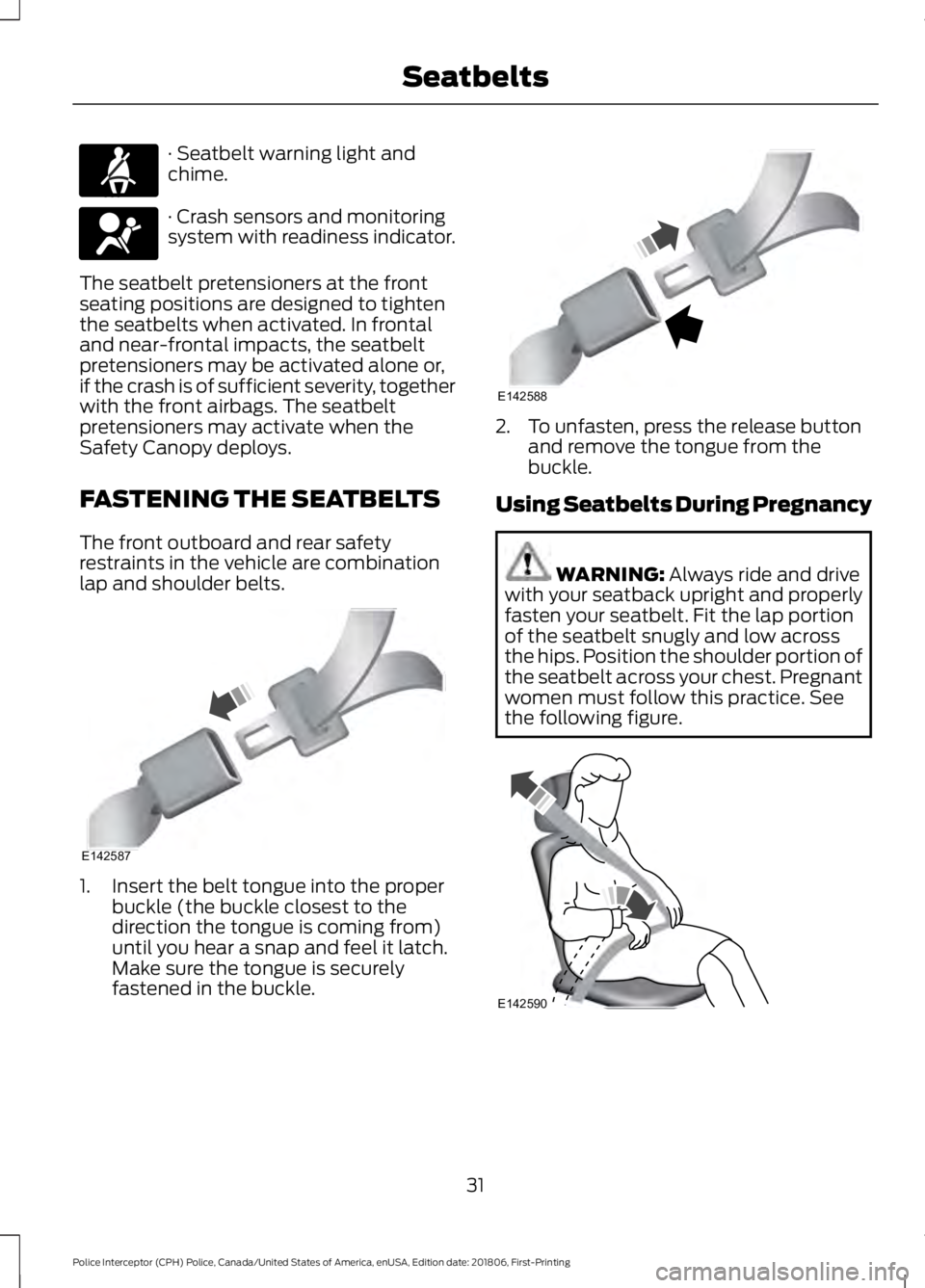
· Seatbelt warning light and
chime.
· Crash sensors and monitoring
system with readiness indicator.
The seatbelt pretensioners at the front
seating positions are designed to tighten
the seatbelts when activated. In frontal
and near-frontal impacts, the seatbelt
pretensioners may be activated alone or,
if the crash is of sufficient severity, together
with the front airbags. The seatbelt
pretensioners may activate when the
Safety Canopy deploys.
FASTENING THE SEATBELTS
The front outboard and rear safety
restraints in the vehicle are combination
lap and shoulder belts. 1. Insert the belt tongue into the proper
buckle (the buckle closest to the
direction the tongue is coming from)
until you hear a snap and feel it latch.
Make sure the tongue is securely
fastened in the buckle. 2. To unfasten, press the release button
and remove the tongue from the
buckle.
Using Seatbelts During Pregnancy WARNING: Always ride and drive
with your seatback upright and properly
fasten your seatbelt. Fit the lap portion
of the seatbelt snugly and low across
the hips. Position the shoulder portion of
the seatbelt across your chest. Pregnant
women must follow this practice. See
the following figure. 31
Police Interceptor (CPH) Police, Canada/United States of America, enUSA, Edition date: 201806, First-Printing SeatbeltsE71880 E67017 E142587 E142588 E142590
Page 37 of 370
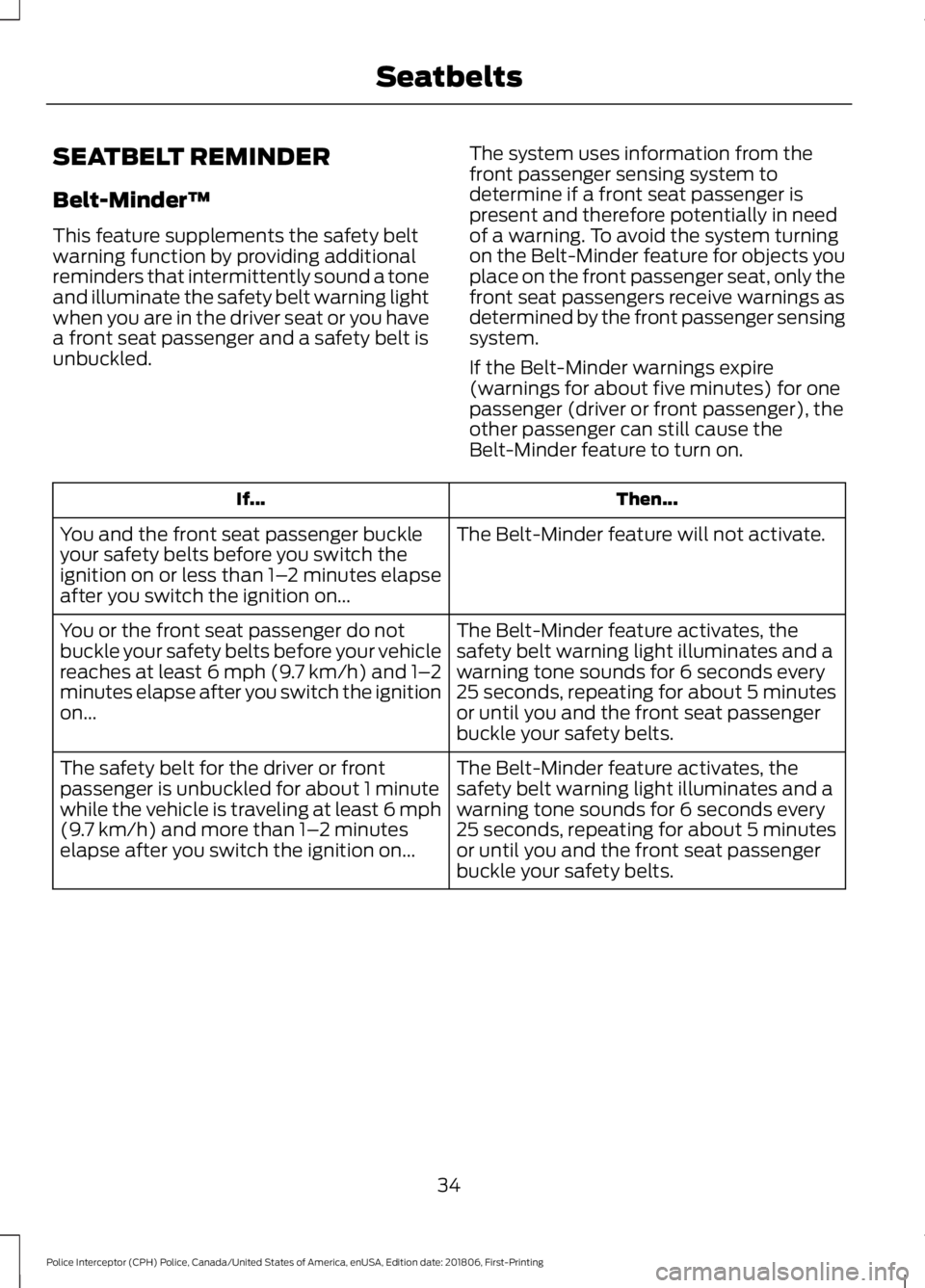
SEATBELT REMINDER
Belt-Minder™
This feature supplements the safety belt
warning function by providing additional
reminders that intermittently sound a tone
and illuminate the safety belt warning light
when you are in the driver seat or you have
a front seat passenger and a safety belt is
unbuckled.
The system uses information from the
front passenger sensing system to
determine if a front seat passenger is
present and therefore potentially in need
of a warning. To avoid the system turning
on the Belt-Minder feature for objects you
place on the front passenger seat, only the
front seat passengers receive warnings as
determined by the front passenger sensing
system.
If the Belt-Minder warnings expire
(warnings for about five minutes) for one
passenger (driver or front passenger), the
other passenger can still cause the
Belt-Minder feature to turn on. Then...
If...
The Belt-Minder feature will not activate.
You and the front seat passenger buckle
your safety belts before you switch the
ignition on or less than 1– 2 minutes elapse
after you switch the ignition on...
The Belt-Minder feature activates, the
safety belt warning light illuminates and a
warning tone sounds for 6 seconds every
25 seconds, repeating for about 5 minutes
or until you and the front seat passenger
buckle your safety belts.
You or the front seat passenger do not
buckle your safety belts before your vehicle
reaches at least 6 mph (9.7 km/h) and 1–
2
minutes elapse after you switch the ignition
on...
The Belt-Minder feature activates, the
safety belt warning light illuminates and a
warning tone sounds for 6 seconds every
25 seconds, repeating for about 5 minutes
or until you and the front seat passenger
buckle your safety belts.
The safety belt for the driver or front
passenger is unbuckled for about 1 minute
while the vehicle is traveling at least 6 mph
(9.7 km/h) and more than 1–
2 minutes
elapse after you switch the ignition on...
34
Police Interceptor (CPH) Police, Canada/United States of America, enUSA, Edition date: 201806, First-Printing Seatbelts